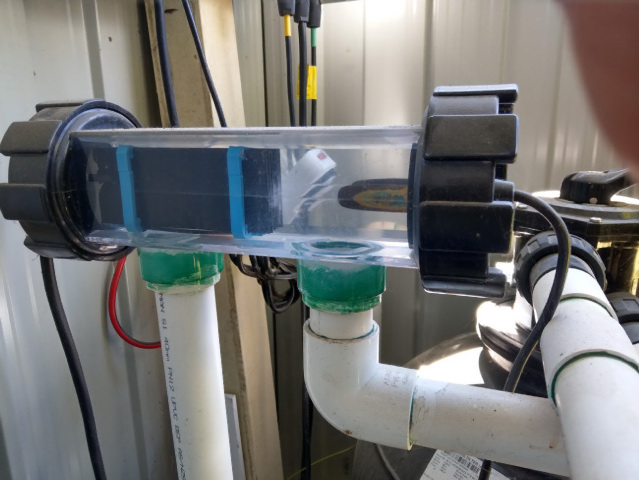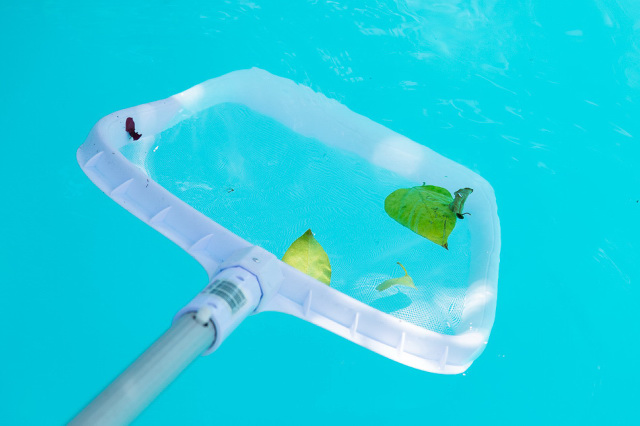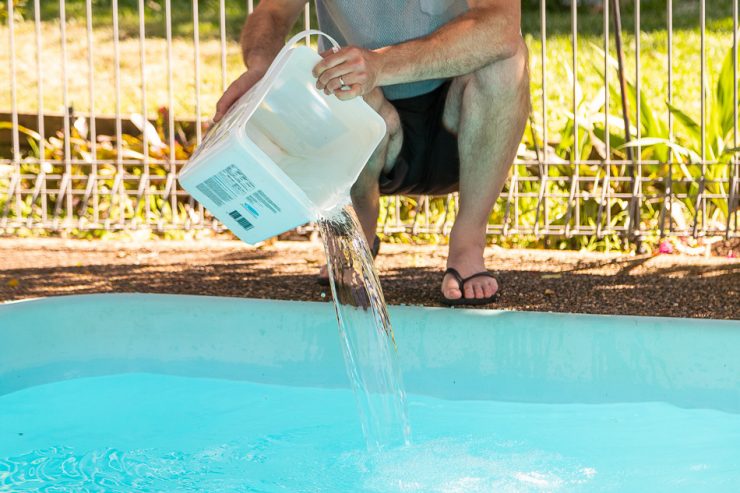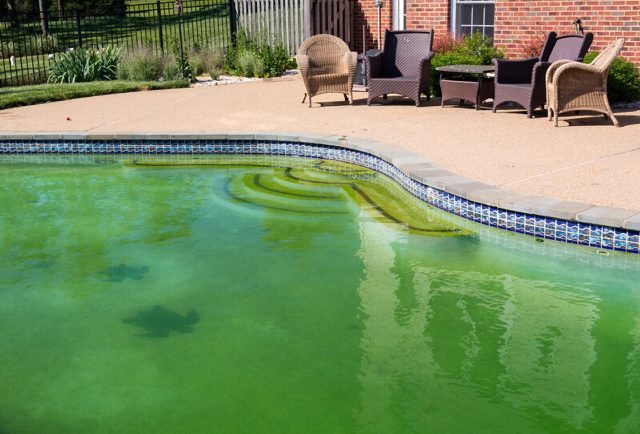If you’re new to owning a saltwater pool, you might be unsure of how to maintain your pool. Does it follow the same guidelines as a traditional chlorine pool? Part of that cleaning routine for your pool is shocking. But, can you shock a saltwater pool? And, if so, how do you shock it?
Shocking a saltwater pool is very similar to how you would shock a typical chlorine pool. However you’ll need to use Dichlor and not Cal-Hypo. Prepare the pool first by balancing the chemicals and then you can add pool shock like you would in a traditional pool.
Although you can shock a saltwater pool just like a chlorine pool, there are a few guidelines and precautions to know beforehand. So, read on and find out the best approach to shocking your saltwater pool.
Article Contents
Is it Ok to Shock a Saltwater Pool?
There is a common misconception that a saltwater pool is completely different from the more traditional chlorine pool. However, both of these pools use chlorine to sanitize themselves. With chlorine pools, you need to manually add chlorine to disinfect the pool. But, saltwater pools create the chlorine themselves.
They generate chlorine by breaking down the salt into sodium and chlorine ions using electrolysis. Then, that chlorine sanitizes the pool. And, any excess chlorine bonds back with sodium and recycles back through the saltwater filtration system.

So, not only is shocking a saltwater pool okay, but it’s actually important to your pool’s health. Shocking is the process in which you overload your pool with chlorine (3-5 times the normal amount) to improve your pool’s cleanliness and kill off organic matter.
Many pool experts choose to use granular pool shock in saltwater systems as it works best and is easy to use. Pool shock is just plain old chlorine, actually.
When selecting a pool shock or chlorine, make sure you pick chlorine that is not stabilized. If you use stabilized chlorine, the pool’s stabilizer levels will go through the roof, creating another problem to deal with.
The HTH Super Shock Pool Chlorine Cleaner is one such pool shock. It has a rating of 4.7 stars out of 8,989 reviews on Amazon.
- Powerful shock treatment and quickly sanitizes, kills algae & organic matter
- Compatible with gunite, concrete, vinyl liners, saltwater systems,
- Each bag treats 13,500 gallons (51K litres) of pool water
This shock shows results in 24 hours and doesn’t fade vinyl pool liners. One 1 lb (0.45 Kg) bag treats 13,500 gal (61,372 L) pools and comes with 11 extra bags too.
Some customers found it to be very potent, leaving stained spots in their pools. To avoid this, make sure you mix it with water first and evenly distribute it throughout the pool. Don’t put it in the skimmer box.
Saltwater Pool Shocking Precautions
Even though chlorine pools and saltwater pools are very similar, how differently they operate is important to be aware of. Because the salt cell of a saltwater pool is responsible for producing chlorine, it’s crucial to make sure it doesn’t overload with the added chlorine from the pool shock.
This is why many pool experts recommend that you turn down, or shut off, your saltwater chlorine generator (SWG) while you’re shocking your pool. Otherwise, you’re running the risk of damaging the salt cell. And that could lead to it not generating enough chlorine after the shocking process finishes. Or an expensive repair.
Choose the Right Saltwater Pool Shock
There are three common types of pool shock available:
- Calcium Hypochlorite (cal-hypo)
- Dichlor
- Liquid chlorine
Cal-hypo should be used for regular chlorine pools. It’s best not to use it regularly for saltwater pools. Cal-hypo contains calcium, which increases calcium (Ca) levels in a pool. Generally saltwater pools have enough calcium which is why it’s best not to use calcium hypochlorite – Ca(ClO)₂.
Instead use dichlor or liquid chlorine to shock your saltwater pool. If you’re using liquid chlorine (bleach) to shock, make sure you add it at night as it is not stabilized.
For more information on choosing the best shock for your pool, check out our article: Which Pool Shock Should You Use? (answered!)
Don’t Swim Whilst Shocking
Another precaution, not exclusive to saltwater pools, is to never swim while shocking your pool. When shocking a pool, the water will be extremely high in chlorine. You don’t want to swim in that.
Regularly check your pool’s chlorine level to make sure it’s back to normal before using the pool. The chlorine level should be between 3.0 and 5.0 ppm (parts per million) prior to any swimming.
Wear Protective Equipment
When handling the pool shock, make sure you wear protective gloves, goggles, and clothes you don’t mind ruining. Chlorine is a hazardous chemical and can harm your skin and end up bleaching your clothes.
How to Shock a Saltwater Pool
When you’re ready to shock your pool, the following steps will ensure you get the best result possible and return your pool’s water to crystal clear.
- Clean the pool
- Balance the pool chemistry levels
- Calculate the dosage
- Add the shock
- Carry out a preliminary chlorine test
It’s worth noting that if you’re treating an outdoor pool, wait to shock it until the sun is setting. The UV rays from the sun will cause some chlorine to burn off otherwise.
1. Clean Your Pool
Before you introduce pool shock to your pool, it’s important to clean your pool first. Carry out your usual pool cleaning routine to remove leaves and dirt from the pool. And don’t forget to clean out the skimmer too.

If you’re shocking your pool to get rid of algae, brush off any spots that have spores before vacuuming to ensure that you’re getting the most out of your pool shock. When it comes to algae, it’s easier to prevent algae from growing than it is to kill it. Check out our article to discover tips on how to prevent algae growth here: Green Pool – Guide to Easily Preventing & Removing Pool Algae
2. Balance Your Pool Chemistry Levels
The next step after cleaning is to ensure the chemical balance within your pool is correct. The following table shows the normal ranges each chemical needs to be in to allow the pool shock to work properly.
| Chemical | Ideal Ranges |
| pH | 7.2 – 7.6 |
| Alkalinity | 120 – 180 ppm |
| Total Hardness | 120 – 425 ppm |
| Calcium Hardness | 180 – 220 ppm |
| Free Chlorine | 3 – 5 ppm |
| Cyanuric Acid (Stabiliser) | 30 – 60 ppm |
Without having these chemicals in their ideal range, the pool shock won’t work for various reasons. For instance, if the pH is high, the shock will be slow to work and be less potent. And if the calcium hardness level is too high, deposits will form.
To help you find out your pool’s levels, use test kits such as the JNW Direct Pool and Spa Test Strips. These strips test for all of the above levels and have a rating of 4.5 stars out of over 29,000 Amazon reviews. Even so, a few customers have noticed their readings are different when compared to other bands and those taken by local pool stores.
A more reliable kit is the Taylor Saltwater drop kit. This is the preferred choice of professional pool maintenance people.
| Image | Product | Features | Link |
|---|---|---|---|
Top Pick  | Taylor Technologies Saltwater Test Kit (K-2006-SALT) This is the saltwater pool test kit we recommend the most because it is extremely accurate and tests for everything you need including: salt, total alkalinity, free and combined chlorine, cyanuric acid, calcium hardness, and pH. | 9.7 | Check Price |
Best Budget  | JNW 7-in-1 Swimming Pool & Spa Test Strips Kit These 7-IN-1 test strips are our recommended budget option. They're quick and easy to use. And they test for Hardness, Chlorine, Bromine, Free Chlorine, pH, Cyanuric acid, and Alkalinity. | 9.5 | Check Price |
3. Calculate The Dosage
When you’re calculating the right chlorine/shock dosage for your pool, it’s important to know the implications if you use too much chlorine.
If your pool has an excess of chlorine after the shock, you’ll have to correct it. Luckily that’s not a big issue. You will just need to leave the pool for another day or two and wait.
Conversely, you need to add enough pool shock if you’re tackling large algae blooms or chloramines. You want to achieve breakpoint chlorination for the shock to do its job, which is about 15-30 ppm.
Chloramines are free chlorine combined with other chemicals (those found in urine and other contaminants). They irritate your skin and eyes and give off that familiar chlorine smell that we all associate with pools.
To accurately calculate the dosage you need, you’ll need to know the volume of your pool. If you still have the pool manual, it’ll tell you how much water your pool can hold. However, if you don’t have access to that manual, you’ll need to do some maths to figure it out.
| Pool Shape | Formula Needed |
| Rectangular | width x length x depth x 7.48 gal (use 28.3 L for litres) |
| Circular | π x radius2 x depth x 7.48 gal (use 28.3 L for litres) |
| Oval | π x ½ width x ½ length x depth x 7.48 gal (use 28.3 L for litres) |
| Variable Depth | Find the average depth: shallow end depth x deep end depth ÷ 2. Use this depth when using other formulas. |
| Irregularly Shaped | Calculate each section using the other formulas and add together |
If you’re using a 12.5% liquid chlorine bleach, you’ll need to add 2.5 gallons (12.5L) per 10,000 gallons (45,461 L).
And, if you’re using granular pool shock (usually cal-hypo), 3 lbs (1.36 Kg) per 10,000 gallons (45,461 L). These dosages will be enough to completely kill any bacteria or algae in your saltwater pool.
Note: it’s best to only use cal-hypo if your calcium levels (Ca) aren’t too high. Use liquid chlorine instead.
4. Add The Pool Shock
Once you’ve worked out the dosage you need for your pool, then it’s time to add it to your pool. Keep the filtration system on so it will help circulate the chlorine around the pool.
When using liquid chlorine, pour it slowly along the pool’s edge. You don’t want any concentrated areas.

If you’re using granular shock and your pool lining is vinyl, painted, or fiberglass, dissolve 1-2 lbs (0.45-0.90 Kg) into a 5 gallon (23 L) bucket full of water first. After that, stir it until it fully dissolves. Then, when you’re applying the shock, make sure the undissolved granules at the bottom of the bucket don’t enter the pool.
Always add the shock to water and not water to the shock.
Following the addition of shock, you can turn off the salt cell or switch it to run at a reduced function.
The shock will take a few days to do its job properly, with most experts advising to wait 3 days. Sometimes, some pool owners aren’t sure how long they should keep their pump running after shocking. So, ease your worries by checking out our article here: How Long Should I run my Pool Pump After Shocking?
5. Test the Water Again
After shocking the pool in the evening, wait until the morning before you test the pool’s chlorine level. The reading should still be quite high. If not, then that means something has already used up all of the shock. Therefore, you’ll need to do another one.
If you have a bad algae problem, this will likely be the case.
After a few days, you may notice your pool is starting to look a cloudy blue color. This isn’t something to worry about as it’s the dead algae and bacteria waiting to filter out. Keep the filter running until your pool’s water is crystal clear.
After the water runs clear, test the chlorine level to make sure it’s normal again. After that, you can turn the saltwater generator back to full power and safely go for a swim.
If you’re not sure when it’s safe to swim in your pool again, check out our article:
How Long After a Shocking Pool Is It Safe to Swim?
When to and Why Shock a Saltwater Pool?
There are many reasons why pool owners shock their pool. Some choose to include it as part of their weekly or bi-weekly cleaning routine (and some pool experts recommend this frequency). Whereas others may only shock their pool if there’s algae growing or a smell of chloramines.
Some of the most common reasons you’d shock your pool include:
- killing algae blooms
- getting rid of chloramines
- excess contaminants
- opening or closing a pool
- fecal accidents
- after heavy rain, storms or wind
- cloudy pool water
Your pool can accumulate bacteria and algae from the wind and its surroundings. And it’s not uncommon for accidents to happen in the pool, leaving fecal particles and urine behind.
Other reasons you may shock your pool include when you’re opening the pool after winter or when closing the pool after summer. After opening your pool, the chlorine in the pool usually needs a boost and shocking can be a great way to do this. If you’re closing your pool for winter, you’ll want to make sure the chlorine level stays at a good level. And, a pool shock will do that.

An important time to shock your pool is after extreme weather conditions. After a windy storm, heavy rain, or during times of extreme heat, shocking your pool is advisable to maintain chlorine levels. Especially if your pool is in direct sunlight. The UV exposure will burn off chlorine and a shock will help boost the chlorine back to normal levels.
Another time you may consider shocking your saltwater pool is if you have cloudy pool water. Although there could be many reasons your salt pool water is cloudy. Check them out here: 15 Reasons Why Your Saltwater Pool Is Cloudy (How to Clear)
Can I Use the Saltwater Chlorine Generator to Shock Pool?
It’s understandable to think that your saltwater generator (chlorinator) could shock the pool itself. Especially, seeing as many new SWG models come with a Super-Chlorinate or Shock mode. This mode can help boost the chlorine in the pool and keep it free of algae and bacteria growth.
But, it only raises the chlorine level by 5-7 ppm and does it too slowly to work well. So, it’s not really a proper shock designed for killing off algae outbreaks or super sanitizing the pool
The chlorinator doesn’t produce enough chlorine quickly enough to properly shock your pool. It generates chlorine consistently but at a lower level than what your pool needs to clear contaminants, algae, etc.
If you try to use your salt cell to shock your pool, you’ll be putting it under too much strain causing it to wear out faster too, reducing its lifespan.
Final Thoughts
Shocking a saltwater pool is not too different to how you shock a traditional chlorine pool. This makes sense, seeing as a saltwater pool is still a chlorine pool.
Choosing when to shock your pool is completely up to your personal preference. I normally advise to shock if you have algae, a fecal accident or after a storm or heavy rain. There’s no need to do it as part of your regular routine. Provided your other maintenance is up-to-date.



I am a little confused. You seem to recommend the HTH super shock for saltwater pools. The bag you show has calcium hypochlorite. Several paragraphs down you state that calcium hypochlorite should not be used in saltwater pools. The bag itself states that it is compatible with salt water systems. Please help.
Thanks for the comment Nev. I’ve made some clarifications in the article. To explain further, whilst calcium hypochlorite isn’t “bad” for saltwater pools, it does have the side effect of increasing calcium levels. Generally saltwater pools already have enough calcium in them. If your pool is low in calcium or not too high, than cal-hypo will be OK. If it’s high in calcium, it’s better to use liquid chlorine (12.5% sodium hypochlorite) instead. This won’t increase the calcium level like cal-hypo will.